“During high-speed pursuit of prey, the cheetah (Acinonyx jubatus) has been observed to swing its tail while manoeuvring (e.g. turning or braking) but the effect of these complex motions is not well understood.”
Prompting, perhaps, the question ‘what is a cheetah’s tail actually for?’

A joint US / South African study (2016) has made made steps towards answers. A set of experiments, in which tails were aerodynamically tested at various airspeeds and inclinations, in a wind tunnel, yielded results :
“[…] our first order, quasi-steady state results clearly support the hypothesis that aerodynamic effects of the cheetah’s long, furry tail contribute to the angular impulse that can be applied to the body, especially at higher speeds. Both inertial and aerodynamic effects must therefore be considered in modelling the use of the cheetah tail for manoeuvring tasks. Our results further support the observations that the cheetah tail can be used as a ‘rudder’ to contribute to fast change of heading, and as a ‘stabiliser’ during rapid acceleration and turning.”
See: Quasi-steady state aerodynamics of the cheetah tail in Biology Open (2016) 5, 1072-1076
Notes:
● The image shows the morphometric tail rig used to measure aerodynamic coefficient at varying angles of inclination and airspeed.
● The authors thank the Ann van Dyk Cheetah Centre for providing the tails.
● The authors inform that the use of the cheetah tails complied with the University of Cape Town Science Faculty Ethics policy.

Published on September 18, 2017 07:00